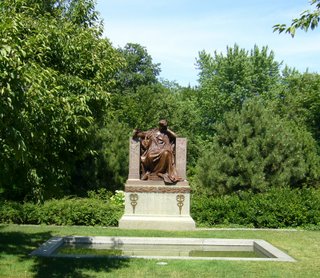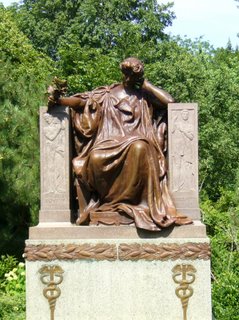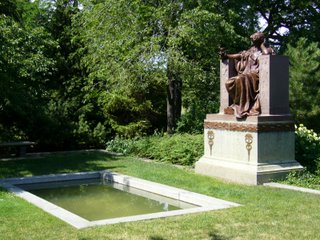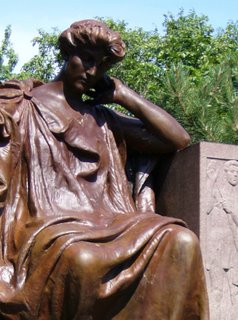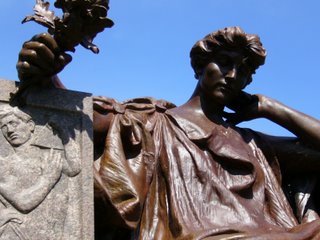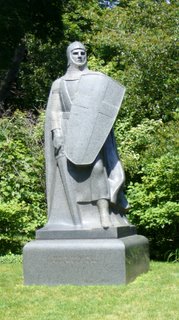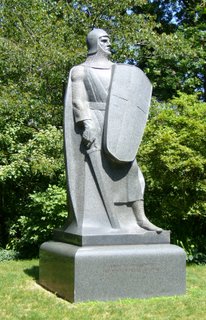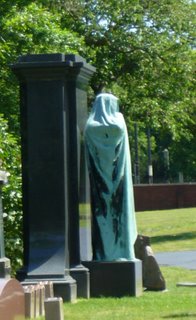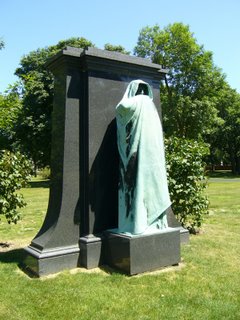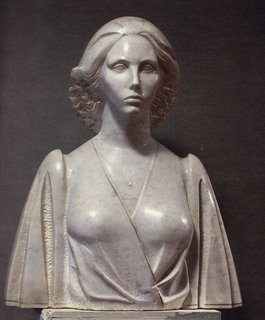Inspired by Conrad's jaunt to his local cemetery -- I paid my first visit (ever) to Chicago's Graceland Cemetery -- the permanent home of many of the city's civic leaders from the late 19th Century.
Despite it's convenient location (I've seen it from the elevated train many, many times) -- it's actually quite inconvenient to visit -- since neither automobiles nor bicycles are allowed - and all the good stuff is about a mile into the park from its one-and-only entrance.
The only (living) person I saw there at all was the security guard -- who turned out to be a very congenial young man (who gave me a lift in his car back to gate at closing time)
The highlight of the park has to be the Greek temple built to shelter the earthly remains of Potter Palmer:
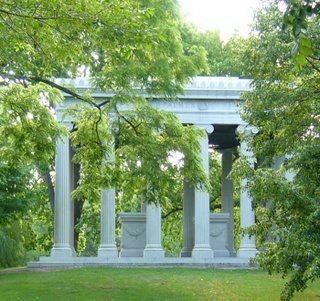


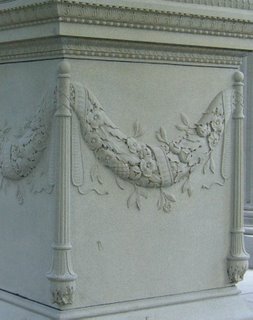
This is maybe the first time (since my life as a traveling salesman) that I've really wanted to be dead --- to lie down peacefully on the lid of that marvelous marble tomb -- feel the breeze off the small adjoining pond -- hear the birds calling in the trees -- close my eyes -- and spend eternity with Mr. and Mrs. Potter Palmer.
Death is so clean -- so fresh -- so bright -- so cheerful -- I just wish I could afford to die in this style.
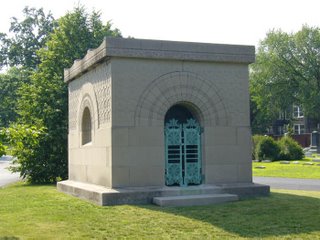
But the real piece-de-resistance of this cemetery is the tomb that the god-like Louis Sullivan designed for Getty.
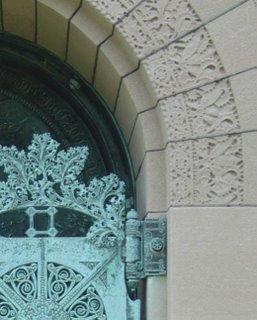
Here is an architect who could have worked at Chartres/Ankhor Wat/Khajuraho -- a prophet of the sun god -- summoning the energy of the life-force -- and declaring Man's place in the universe. (if only he had been building temples and cathedrals -- instead of banks/department stores/and this little crypt)
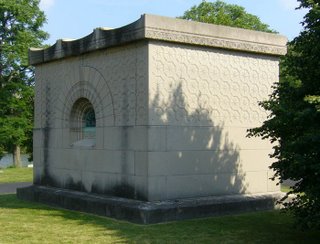
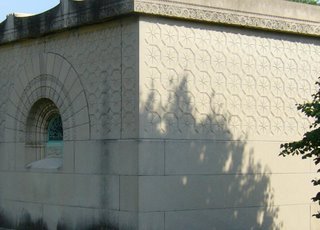
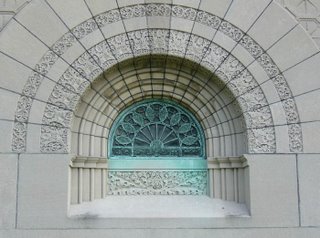
And actually -- I don't think this is a monument to death or a tomb at all -- it's a small temple to the sun -- shown here radiating forth its energies.

It's been officially declared as an avant garde triumph -- an early gem of Modern Architecture -- but maybe it's just good architecture that looks different from the dominant styles of its time.
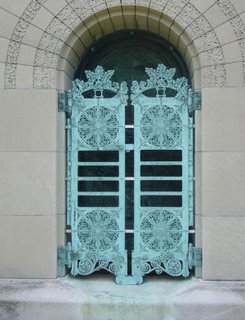
And I love the metalwork in this cemetery -- not just on the Getty tomb -- although Sullivan's ornament is in a class-by-itself -- not powerfully separating us from the sacred world of the dead (as the heavy metalwork does on the doorways of other crypts) -- but establishing a barrier of mystery -- like the frilly lacework of women's panties.
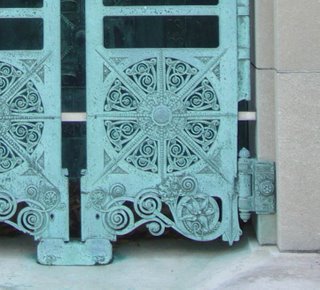
And now - I guess it's appropriate to visit the memorial to Louis himself:
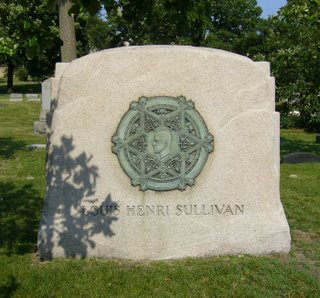
The problem is, though -- how can I put this -- it sucks. The ornament is a characature of what Sullivan would have done -- and the sculptural relief is less than mediocre -- this piece is an embarassment !
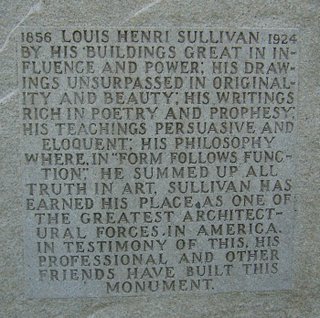
Nor is it helped by this screed carved on the opposite side of the stone -- in poorly designed typography -- telling us about what "SUMS UP ALL TRUTH IN ART" -- as if the person who designed this monument had any credibility on this subject.
(note: actually -- it may be that L.H.S. was not the icon of architecture in 1924 as he is today. He died broke -- unemployed -- and alcoholic -- and his friends, including Frank Lloyd Wright, may not have had the available funds to do this project justice)
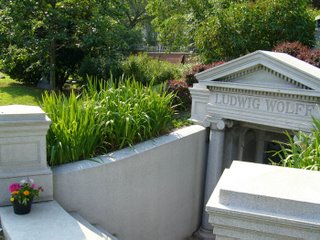
But now -- going back to my favorite theme for the day -- the longing for death -- doesn't this doorway to the underground seem inviting ? Especially on a hot summer day -- when the temperature in that crypt has got to be about 20 degrees cooler ?

Welcome my friend ! We've been waiting for you ! Take a load off your feet -- make yourself comfortable -- let's spend eternity together.

This structure so different in both shape and surface - the dark, polished marble reflecting the color that surrounds it.
My question here is: does this delightful medieval fantasy belong in a cemetery ? It seems so bombastic and playful -- better suited perhaps for an amusement park -- definately proclaiming its inhabitant, Martin Ryerson, as an eccentric individual.
(his name was given , by the way, to the art museum's library -- so I guess I should pay that eccentricity its due respect)

For some reason, it seems very important to separate the living from the dead in this park -- and this gate does a convincing job -- without resorting to the bicycle chains that so many other crypts eventually required. It looks like the door to a bank vault, doesn't it ? I guess that means that he was .... rich.

And what a magnificent detail -- as if the power of design all came down to this tiny keyhole - and the mystery that is locked behind it.
(subsequent to writing the above -- I've learned that the Martin Ryerson being honored was, in fact, the father of the Martin Ryerson who gave so many paintings and books to the Art Institute, although since he was 29 at the time of his father's death, he may have been the one who selected the architect and approved the design. I've also learned that the architect involved was Louis Sullivan -- and the basic design came from ancient Egypt -- although I still think it belongs in the Très Riches Heures of the Duc de Berry)
So L.H.S. made this one, too, did he ? I'm a bit disappointed -- that it wasn't another architect who was equally capable of providing such fine ornamental detail.

And here's another architect working with some of the same elements -- but what a difference ! This one was probably made in the same decade -- but it certainly appears to be post-modern -- i.e. it's an collection of tropes -- like all the fal-der-ol printed on an American dollar bill. Bad sculpture -- mediocre ornament -- not even an attempt to properly space the rows of stone blocks -- but at least it's faults were a century ahead of their time !

Back to another Greek temple -- how I love these things ! Life seems so glorious at the foot of a row of white columns
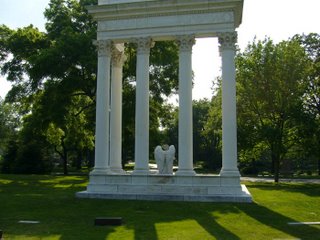
And something about this big -- somewhat awkward -- somewhat decaying angel -- makes me think of the final scenes of one of my favorite films: Tony Kushner's "Angels In America"
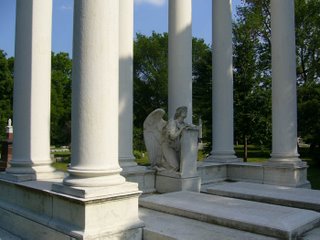
Isn't this that big sexy American angel that's so frightening -- so attractive -- and perhaps just as confused about what's happening as we are ?
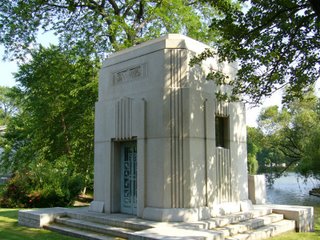
There isn't much art-deco in this cemetery -- but what a magnificent piece this is! The 20's were a golden age in sculpture and design -- and that optimism is so contagious. (if only the rest of the 20th century hadn't turned out to be such a nightmare)
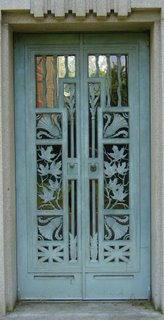
What playfulness ! -- what high spirits ! This isn't a tomb -- it's a changing-room for swimmers who will dive into the pool behind. Or -- if it is a tomb -- it's where the great Gatsby lies buried.
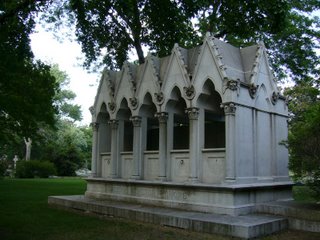
Has any style been left out ? Yes -- of course -- the Gothic -- and here's the most extravagant example -- by the New York architects McKim, Mead and White (who also did the Morgan Library)
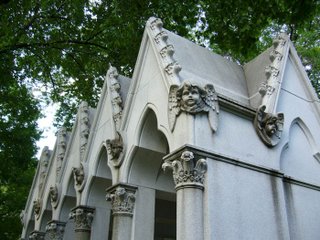
The Gothic abounds in Chicago architecture -- especially in universities -- but rather than the Gothic I've seen in France and Italy -- here it always seems kind of dark, creepy, and cartoonish to me. (I'm sure that bats have nested inside this place)
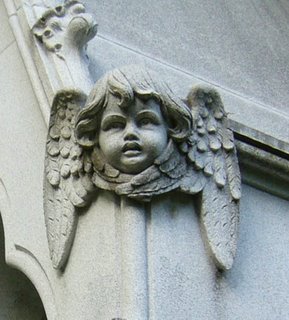
But this is a nice example of eyebrows as arches -- sculpture as architecture.
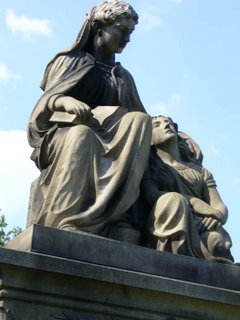
And speaking of sculpture -- that WAS the reason I made this trip -- and the above seems typical of the best that can be found.

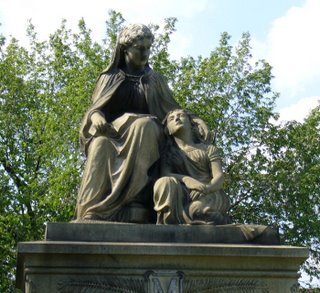
My favorite statues in the city are the pair of Tang Dynasty garden
boddhisatvas at the Art Institute -- and now I'm wondering what's the difference.
In both cases -- the sculptors were fulfilling a specific social need -- in both cases that need was for making a place quiet and meditative -- in both cases the names of the sculptors have been lost -- (even though the one is barely 100 years old) -- because, of course, they weren't expressing themselves -- they weren't innovating, and they weren't making 'art'.
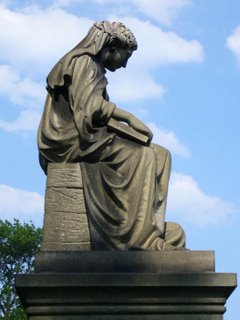
For me, this piece just misses --- well, the above tired view misses a bit more -- like many of things I see at my art club. It's well made -- it's touching -- but it's not memorable -- it's just pleasant --- and when contemplating eternity (as one is asked to do at a cemetery) -- I need something prophetic.
But the guild of 19th Century cemetery carvers was a noble fellowship -- they did good work -- they trained their next generations to do good work -- and if it weren't for the over-the-top architectural showpieces at Graceland -- their work would have been what made this place memorable.
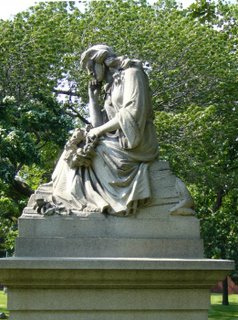
Here's another monumental sculpture -- it certainly has a different feeling -- a troubled, melancholy feeling -- not exactly what I enjoy looking at -- but this is a cemetery after all -- and death isn't always welcome.

I just get the feeling that this sculptor should have been doing something more dramatic -- perhaps a civil war battle scene.

Many of the stone pieces in this park have fared poorly -- dissolving in the acid rain -- melting away like a snowman in March -- but the following figure has stood the test of time

It was made by the Schuyler Parsons Landon company of Bridgeport Conn., and it is proudly labeled on base as "White Broze" -- i.e pure zinc. Apparently this company did a lot of business in cemeteries and Civil War memorials.
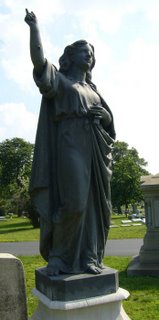
Like the artisans who work for Jeff Koons, the actual sculptor did not sign his work -- but that doesn't mean that he wasn't very good.
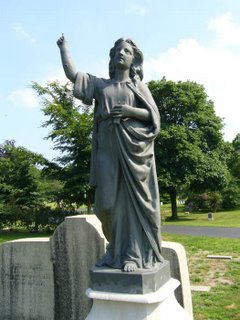
I'd say this is a fine American angel -- and I do wonder whether -- in a few hundred years -- these anonymous Victorian cemetery sculptures will be as treasured as the relics from Medieval France or Cambodia are today -- once the modern artworld has been footnoted as a curious abberation.
..................................................................................
(note: this entry is a work in progress -- more pictures and reflections will follow)
